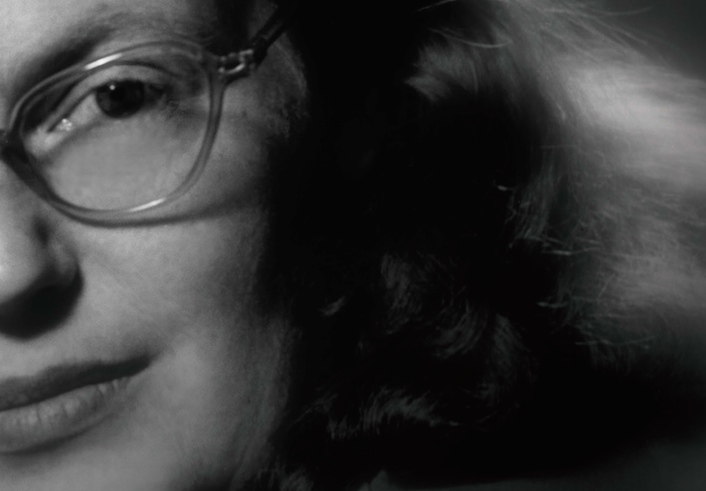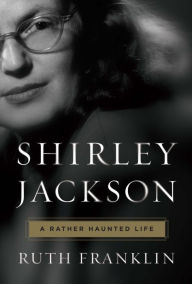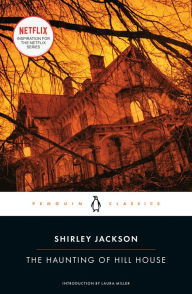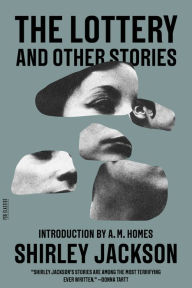Shirley Jackson: A Rather Haunted Life

“You once wrote me a letter . . . telling me that I would never be lonely again. I think that was the first, the most dreadful lie you ever told me.”
This wrenching lines appear twice in Ruth Franklin’s magisterial biography Shirley Jackson: A Rather Haunted Life and are, by some measures, the beating heart of the book. They are taken from an undated letter Jackson wrote to her husband, literary critic Stanley Edgar Hyman. But Franklin employs them not so much for what they reveal about Jackson’s frequently unhappy marriage but instead to tease out the many murky nuances of what “lonely” meant for Jackson — as a writer whose work frequently defied categorization, as a woman chafing against her era’s notions of what a woman could be, and as an artist of singular talent in a time and place when singularity was often suspect..
Like countless writers — particularly writers who are women — Jackson seldom felt a sense of belonging, not in her stolidly conventional family, nor in the starry New York City literary scene, not in the conservative New England towns in which she and Hyman raised their own family, nor, more largely, in the suffocating, gender-polarized environment of midcentury America. The manner and force by which this loneliness fired her imagination and drove her talent — fierce, complicated and, mostly sustaining — is the story Franklin tells.
Shirley Jackson: A Rather Haunted Life
Shirley Jackson: A Rather Haunted Life
Hardcover $35.00
“Shirley Jackson has always been an original who walks by herself,” wrote Orville Prescott in his New York Times review of We Have Always Lived in the Castle. “There is magic in her books, and baffling magic some of it is, too.” Indeed, since Jackson first began publishing stories in the early 1940s, there have been critics, editors, and befuddled readers who simply did not know what to do with her. From her psychologically twisty novels to her madcap family memoirs and her wildly diverse stories, which range from Puritan Gothic to family sketches to deft studies in social mores, Jackson’s work both defies simple categorization and exposes the limits of such categories, of genre itself.
Born in 1916 and raised in comfortable bourgeois surroundings in and around Burlingame, California, Jackson was inspired from an early age by voracious reading of folktales, mythology, the Oz books, and commedia dell’arte. Writing was an escape from her family’s efforts to, as Franklin puts it, “mold their daughter into a typical upper-middle-class California girl: proper, polite, demure.” When she was seventeen, her family moved to Rochester, New York, transplanting Jackson from her home and friends to a frigid industrial city where she felt even more out of place. Her late teens and early twenties were a series of half-starts and depressive episodes, including a troubled stint at the University of Rochester, before finding a happier home at Syracuse University. There, she began making important friendships with fellow outsiders and artists, including one that would change her life.
When Jackson met budding intellectual Stanley Hyman at Syracuse in 1938, their connection was swift and intense. They would remain together, for better or for worse, until Jackson’s death to heart failure at age forty-eight. It was with Hyman that Jackson initially found the personal and intellectual communion for which she so longed, and Franklin ably captures the intoxicating and brainy energy of the early years of their relationship, from shared reading adventures to liquor-fueled parties with such luminaries as Ralph Ellison, one of Hyman’s closest friends, and Dylan Thomas — who either did or didn’t drunkenly chase Jackson around her house and share a private moment with her outside in the snow. Franklin even offers a delicious anecdote of a party at the Hyman-Jackson home in 1950 that included a neighbor who brought an old college friend: Bette Davis. Jackson took out a guitar and a sing-along ensued.
Before they even married, however, Hyman confessed to liaisons with other women, suggesting Jackson accept his infidelity as part of his nature. “They were a perfect pairing, writer and critic, gentile and Jew, S & S,” Franklin writes. But, for Franklin, their symbiosis to often turned “parasitic.” She speculates that Jackson’s lifelong fascination with magic and witchcraft may have been a way to counteract the “lack of agency she felt in her own life and her corresponding longing to harness power.” Hyman had the unique capacity to energize and yet undermine her work, to cling to her and yet strip her of her confidence by his affairs, to encourage her writing but to push her to write “socially conscious” stories he favored or, eventually, the domestic ones that sold.
As their family grew, ultimately to four children, Hyman urged his wife to take on lucrative assignments from the likes of Good Housekeeping, McCall’s, and Woman’s Day, even criticizing her for squandering her writing time on letters to relatives or friends. As a result, Jackson spent most of her adult life fitting writing into every spare corner of time while she ran a busy household, maintained her role as faculty wife, and managed her publishing career. Hyman, meanwhile, took years to complete his considerably less lucrative books of literary criticism. The pressures, compounded by her sense of being the “eccentric” in Bennington and the other New England towns in which they landed, weighed heavily on Jackson.
Jackson’s experience of motherhood was far less complicated. Franklin offers a portrait of an engaged and loving mother, deeply curious about her children and eager to celebrate their differences. Thanks to the participation of all of the children, Franklin brings to vivid life the chaotic and lively Jackson-Hyman household but also untangles it from the spirited portrayal in Jackson’s wildly popular domestic memoirs, Life Among the Savages (1953) and Raising Demons (1957) — books that were authentic reflections but also shaped by an author very aware of the marketplace.
“Shirley Jackson has always been an original who walks by herself,” wrote Orville Prescott in his New York Times review of We Have Always Lived in the Castle. “There is magic in her books, and baffling magic some of it is, too.” Indeed, since Jackson first began publishing stories in the early 1940s, there have been critics, editors, and befuddled readers who simply did not know what to do with her. From her psychologically twisty novels to her madcap family memoirs and her wildly diverse stories, which range from Puritan Gothic to family sketches to deft studies in social mores, Jackson’s work both defies simple categorization and exposes the limits of such categories, of genre itself.
Born in 1916 and raised in comfortable bourgeois surroundings in and around Burlingame, California, Jackson was inspired from an early age by voracious reading of folktales, mythology, the Oz books, and commedia dell’arte. Writing was an escape from her family’s efforts to, as Franklin puts it, “mold their daughter into a typical upper-middle-class California girl: proper, polite, demure.” When she was seventeen, her family moved to Rochester, New York, transplanting Jackson from her home and friends to a frigid industrial city where she felt even more out of place. Her late teens and early twenties were a series of half-starts and depressive episodes, including a troubled stint at the University of Rochester, before finding a happier home at Syracuse University. There, she began making important friendships with fellow outsiders and artists, including one that would change her life.
When Jackson met budding intellectual Stanley Hyman at Syracuse in 1938, their connection was swift and intense. They would remain together, for better or for worse, until Jackson’s death to heart failure at age forty-eight. It was with Hyman that Jackson initially found the personal and intellectual communion for which she so longed, and Franklin ably captures the intoxicating and brainy energy of the early years of their relationship, from shared reading adventures to liquor-fueled parties with such luminaries as Ralph Ellison, one of Hyman’s closest friends, and Dylan Thomas — who either did or didn’t drunkenly chase Jackson around her house and share a private moment with her outside in the snow. Franklin even offers a delicious anecdote of a party at the Hyman-Jackson home in 1950 that included a neighbor who brought an old college friend: Bette Davis. Jackson took out a guitar and a sing-along ensued.
Before they even married, however, Hyman confessed to liaisons with other women, suggesting Jackson accept his infidelity as part of his nature. “They were a perfect pairing, writer and critic, gentile and Jew, S & S,” Franklin writes. But, for Franklin, their symbiosis to often turned “parasitic.” She speculates that Jackson’s lifelong fascination with magic and witchcraft may have been a way to counteract the “lack of agency she felt in her own life and her corresponding longing to harness power.” Hyman had the unique capacity to energize and yet undermine her work, to cling to her and yet strip her of her confidence by his affairs, to encourage her writing but to push her to write “socially conscious” stories he favored or, eventually, the domestic ones that sold.
As their family grew, ultimately to four children, Hyman urged his wife to take on lucrative assignments from the likes of Good Housekeeping, McCall’s, and Woman’s Day, even criticizing her for squandering her writing time on letters to relatives or friends. As a result, Jackson spent most of her adult life fitting writing into every spare corner of time while she ran a busy household, maintained her role as faculty wife, and managed her publishing career. Hyman, meanwhile, took years to complete his considerably less lucrative books of literary criticism. The pressures, compounded by her sense of being the “eccentric” in Bennington and the other New England towns in which they landed, weighed heavily on Jackson.
Jackson’s experience of motherhood was far less complicated. Franklin offers a portrait of an engaged and loving mother, deeply curious about her children and eager to celebrate their differences. Thanks to the participation of all of the children, Franklin brings to vivid life the chaotic and lively Jackson-Hyman household but also untangles it from the spirited portrayal in Jackson’s wildly popular domestic memoirs, Life Among the Savages (1953) and Raising Demons (1957) — books that were authentic reflections but also shaped by an author very aware of the marketplace.
We Have Always Lived in the Castle: (Penguin Classics Deluxe Edition)
We Have Always Lived in the Castle: (Penguin Classics Deluxe Edition)
By
Shirley Jackson
Introduction
Jonathan Lethem
Illustrator
Thomas Ott
In Stock Online
Paperback $17.00
According to Franklin, the greatest pressures on Jackson and the source of much of her anxiety and unhappiness, which eventually led her to periods of agoraphobia and what Jackson called “nervous hysteria,” are a consequence of the era in which she lived. The expectations and demands postwar America placed on middle-class women to keep home and hearth and achieve a kind of domestic perfection were uniquely high. Even Jackson’s New York Times obituary refers to her as a “neat and cozy woman” and features the reassuring subheading “Housework Came First.” Jackson couldn’t escape strictures from the opposite side of the ideological aisle, either: Franklin reports Betty Friedan’s critique of Jackson as one of those “new breed of women writers” who reject their craft in favor of cloying, propagandist accounts of domestic pleasure. Friedan’s narrow point of view didn’t allow for Jackson’s unique, incendiary power. As Franklin ably argues, Jackson’s family memoirs contain “genuinely subversive” elements, such as showing both a mother’s faux-murderous frustration in much of her responsibilities and her unabashed pleasure in escaping them, whether into a “weekend away or . . . two martinis to get through the dinner hour.” Touchingly, Franklin quotes a condolence letter from a “housewife on Long Island” to Hyman after Jackson’s death, noting, “She was one of us, and greater and smarter, and funnier than any of us. It was good to know she was there.”
According to Franklin, the greatest pressures on Jackson and the source of much of her anxiety and unhappiness, which eventually led her to periods of agoraphobia and what Jackson called “nervous hysteria,” are a consequence of the era in which she lived. The expectations and demands postwar America placed on middle-class women to keep home and hearth and achieve a kind of domestic perfection were uniquely high. Even Jackson’s New York Times obituary refers to her as a “neat and cozy woman” and features the reassuring subheading “Housework Came First.” Jackson couldn’t escape strictures from the opposite side of the ideological aisle, either: Franklin reports Betty Friedan’s critique of Jackson as one of those “new breed of women writers” who reject their craft in favor of cloying, propagandist accounts of domestic pleasure. Friedan’s narrow point of view didn’t allow for Jackson’s unique, incendiary power. As Franklin ably argues, Jackson’s family memoirs contain “genuinely subversive” elements, such as showing both a mother’s faux-murderous frustration in much of her responsibilities and her unabashed pleasure in escaping them, whether into a “weekend away or . . . two martinis to get through the dinner hour.” Touchingly, Franklin quotes a condolence letter from a “housewife on Long Island” to Hyman after Jackson’s death, noting, “She was one of us, and greater and smarter, and funnier than any of us. It was good to know she was there.”
The Haunting of Hill House
The Haunting of Hill House
By
Shirley Jackson
Introduction
Laura Miller
In Stock Online
Paperback $16.00
While her memoirs made Jackson a bestseller and her brilliant and virtuosic novels — foremost We Have Always Lived in the Castle and The Haunting of Hill House — have ensured her legacy, most readers today, if they know Jackson, know her from her unforgettable (and endlessly anthologized) short story, “The Lottery.” Its publication in The New Yorker in 1948 changed Jackson’s life forever. Franklin shows how — her privacy invaded, her personal life parsed, her mailbox flooded by frequently angry or accusatory letters from readers across the globe — Jackson came to rue the story’s success even as she knew it made her name. By approaching the well-worn story and its impact on Jackson from every angle –literary, cultural, and personal –Franklin breathes new life into it, and it is in such close parsing of the texts themselves that A Rather Haunted Life truly dazzles.
Rare is the author biography (Blake Bailey’s study of Richard Yates is another) that so thoroughly explores and illuminates the subject’s writing itself. Franklin offers inspired discussion of every novel, both memoirs, and many of the major stories. It is with the same keen literary-investigative eye that Franklin makes astute but measured connections between Jackson’s work and life._ One illuminating example is a discussion of two letters Jackson wrote but never sent. The first occurs after Jackson receives a note from her mother — a source of lifelong anxiety for Jackson — criticizing her appearance after seeing her daughter photographed in a Time magazine profile. Jackson’s initial, unsent reply demands her mother cease her “unending” critiques. Franklin finds a canny parallel when, early in their relationship, Jackson wrote Hyman an angry, broken letter after he confided an infidelity. Once more, she never sent it, never let her pain reach its source. Both mother and husband provoke her rage and break her heart, yet Jackson stifles herself — not on the page, but the pages never reach their intended recipient. Her fiction, however, is where those feelings find their home.
While her memoirs made Jackson a bestseller and her brilliant and virtuosic novels — foremost We Have Always Lived in the Castle and The Haunting of Hill House — have ensured her legacy, most readers today, if they know Jackson, know her from her unforgettable (and endlessly anthologized) short story, “The Lottery.” Its publication in The New Yorker in 1948 changed Jackson’s life forever. Franklin shows how — her privacy invaded, her personal life parsed, her mailbox flooded by frequently angry or accusatory letters from readers across the globe — Jackson came to rue the story’s success even as she knew it made her name. By approaching the well-worn story and its impact on Jackson from every angle –literary, cultural, and personal –Franklin breathes new life into it, and it is in such close parsing of the texts themselves that A Rather Haunted Life truly dazzles.
Rare is the author biography (Blake Bailey’s study of Richard Yates is another) that so thoroughly explores and illuminates the subject’s writing itself. Franklin offers inspired discussion of every novel, both memoirs, and many of the major stories. It is with the same keen literary-investigative eye that Franklin makes astute but measured connections between Jackson’s work and life._ One illuminating example is a discussion of two letters Jackson wrote but never sent. The first occurs after Jackson receives a note from her mother — a source of lifelong anxiety for Jackson — criticizing her appearance after seeing her daughter photographed in a Time magazine profile. Jackson’s initial, unsent reply demands her mother cease her “unending” critiques. Franklin finds a canny parallel when, early in their relationship, Jackson wrote Hyman an angry, broken letter after he confided an infidelity. Once more, she never sent it, never let her pain reach its source. Both mother and husband provoke her rage and break her heart, yet Jackson stifles herself — not on the page, but the pages never reach their intended recipient. Her fiction, however, is where those feelings find their home.
The Lottery: And Other Stories
The Lottery: And Other Stories
By
Shirley Jackson
Introduction
A. M. Homes
Paperback $15.00
If there is a constant in Jackson’s stories and nearly all her novels, it is on a character feeling alone among others, even her own family (The Bird’s Nest, Hangsaman, The Haunting of Hill House), or a family standing apart and isolate from the larger community or world (We Have Always Lived in the Castle, The Sundial). In the last few years of her short life, the spotlight more intense, her marriage foundering, children leaving the household one by one, Jackson’s loneliness and anxiety seemed to overwhelm her. But she mined these emotions always and found an immense readership by doing so. “Insecure, uncontrolled, i [sic] wrote of neuroses and fear,” she wrote in her diary, “and i think all my books laid end to end would be one long documentation of anxiety.” That is a statement that, however specific to Jackson’s psyche, denotes something larger and more resonant: how a writer’s anxiety, pain, and anger can take darkly luminous shape, ready to be shared with readers in a way that we don’t comprehend so much as experience as revelation. Jackson’s imagination transmits to us the hauntedness of love and of family and the essential loneliness that stories (and perhaps stories alone) have the power to efface.
If there is a constant in Jackson’s stories and nearly all her novels, it is on a character feeling alone among others, even her own family (The Bird’s Nest, Hangsaman, The Haunting of Hill House), or a family standing apart and isolate from the larger community or world (We Have Always Lived in the Castle, The Sundial). In the last few years of her short life, the spotlight more intense, her marriage foundering, children leaving the household one by one, Jackson’s loneliness and anxiety seemed to overwhelm her. But she mined these emotions always and found an immense readership by doing so. “Insecure, uncontrolled, i [sic] wrote of neuroses and fear,” she wrote in her diary, “and i think all my books laid end to end would be one long documentation of anxiety.” That is a statement that, however specific to Jackson’s psyche, denotes something larger and more resonant: how a writer’s anxiety, pain, and anger can take darkly luminous shape, ready to be shared with readers in a way that we don’t comprehend so much as experience as revelation. Jackson’s imagination transmits to us the hauntedness of love and of family and the essential loneliness that stories (and perhaps stories alone) have the power to efface.



